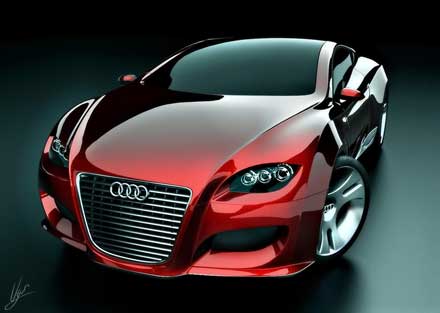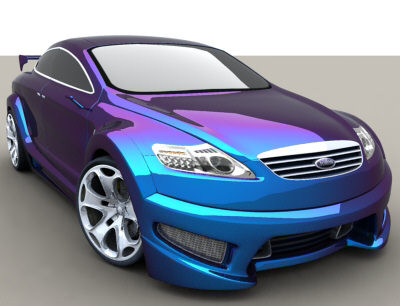 Since we’re still a few months away from the Insignia’s debut that will take place at the London Motor Show on July 2, Opel decided to give us a second set of teaser shots following an initial picture of the car’s tail-lamp that was released last November. The Insignia will replace the Vectra in Europe while it’s speculated that the mid-size sedan will most possibly succeed the Saturn Aura in the
Since we’re still a few months away from the Insignia’s debut that will take place at the London Motor Show on July 2, Opel decided to give us a second set of teaser shots following an initial picture of the car’s tail-lamp that was released last November. The Insignia will replace the Vectra in Europe while it’s speculated that the mid-size sedan will most possibly succeed the Saturn Aura in the  Along with the darkened front-end, GM’s German subsidiary published a few shots of the Insignia’s headlights that feature Opel’s new generation AFL technology that automatically adjusts headlamp beam distribution to the prevailing road profile and visibility conditions. The AFL headlamps, which will make their debut on the Insignia, also boast innovations such as LED daytime running lamps as standard, which require considerably less electricity, and therefore, less fuel. –Click through for details and more images
Along with the darkened front-end, GM’s German subsidiary published a few shots of the Insignia’s headlights that feature Opel’s new generation AFL technology that automatically adjusts headlamp beam distribution to the prevailing road profile and visibility conditions. The AFL headlamps, which will make their debut on the Insignia, also boast innovations such as LED daytime running lamps as standard, which require considerably less electricity, and therefore, less fuel. –Click through for details and more images

 Overview of the AFL’s nine lighting functions:
Overview of the AFL’s nine lighting functions:
·The Pedestrian Area Light is activated automatically at speeds between five and 30 km/h. It is designed especially for zones where the driver must exercise extreme caution, such as residential areas with corresponding traffic restrictions. The function adjusts the cone of light for both headlamps by eight degrees toward each roadside.
With this light, pedestrians and children playing next to the road – who often cannot properly judge the speed of a moving vehicle – can be seen earlier, particularly when cars are also parked on the roadside.
·The Country Road Light provides a brighter and wider beam to both sides of the road than a conventional low beam. This helps drivers see animals at the sides of the road earlier. It is activated between 50 and
100 km/h and projects a beam 70 meters ahead.
·With the Highway Light, beam intensity is increased and the headlamps set slightly higher, because there is no risk of blinding oncoming traffic and the smoother road surface causes fewer vehicle body movements. The Highway Light creates a cone of light that illuminates the road 140 meters ahead and the
left-hand roadside better. An increase in electrical output from 35 to 38 watts also provides a noticeable improvement in visibility. The Highway Light activates automatically above 100 km/h, but only when the steering angle sensor indicates that the road’s curve radii do not match those of a country road.
·The Adverse Weather Light is activated during rain or snow when the rain sensor detects a certain amount of rain or when the windshield wipers are switched on and off in rapid succession. The light output is then distributed asymmetrically: the right headlamp beam is increased from 35 to 38 watts so the driver can see the guiding lines better, and the left headlamp decreased from 35 to 32 watts to reduce the risk of blinding oncoming drivers, which is often the case on wet, reflective road surfaces. The right light cone is also much brighter and the left cone slightly shortened.
·The High Beam Light (already included in the current AFL generation) provides maximum headlamp beam output and range. Rather than beam asymmetrically, the High Beam Light optimally illuminates the full width of the road. The headlamps’ output also increases from 35 to 38 watts.
·The High Beam Light Assistant is an innovation in this segment and offers a considerable safety advantage when driving in darkness. The Assistant automatically activates the High Beam Light for better road illumination and thereby improved visibility. The system’s camera recognizes the headlamps or tail lights of other vehicles and automatically switches the headlamps to low beam when required to prevent blinding other road users.
·The Dynamic Curve Light (already included in the current AFL generation) ensures improved illumination in curves. Curve Light’s swiveling bi-xenon headlamps shine at up to 15° right and left of the vehicle into the oncoming curve. The Curve Light angle is determined by the car’s speed and steering angle. A new addition to this system is the sport switch, which when activated enables a more dynamic response from AFL. The Cornering Lights are controlled quicker and the Dimm characteristic curve has been modified for quicker response.
·The Static Cornering Light (already included in the current AFL generation) illuminates an area to the right or left of the vehicle up to an angle of 90 degrees, making maneuvering easier in poorly illuminated areas, such as on dark access roads. It is activated at speeds below 40 km/h or when the car is put into reverse gear. A new function is the delayed switch over to the normal low beam headlamps to make drive-away maneuvers easier.













